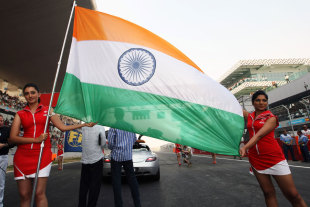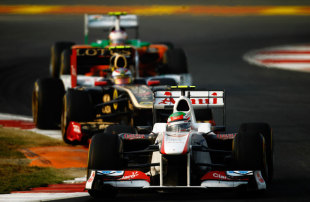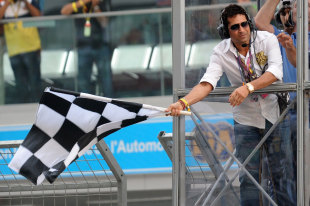
- Race:
- Indian Grand Prix
- Drivers:
- Lewis Hamilton
- |
- Christian Horner
- |
- Vijay Mallya
- |
- Bruno Senna
- |
- Sebastian Vettel
- |
- Martin Whitmarsh
- Teams:
- McLaren
- |
- Racing Point
- |
- Red Bull
As the dust quite literally settles at the Buddh International Circuit, it's hard not to declare India's inaugural grand prix a success. There have been teething problems - dogs on the circuit, rats in the garages and a bat in the media centre to name just the animal-themed ones - but somehow the charm of the place, and its people, plastered over the very visible cracks.
There's a legitimate concern in F1 that the glut of Hermann Tilke-designed circuits on the calendar has removed some of the character from the sport, but Buddh proved that that doesn't have to be the case. The paddock buildings may bear a closer resemblance to London's Trellick Tower than Bernie Ecclestone's vision for F1's future, but importantly they managed to host a grand prix unlike any other in F1. The organisers took the basic Tilke ingredients, which are actually pretty sound, and added their own flavour to make something unique.
Ironically, part of the circuit's built-in character came from its unfinished construction, such as a staircase that lead to nowhere, paths that wobbled underfoot and drain covers that didn't quite cover drains. But the character mainly came from the enthusiasm of the organisers and fans, which bodes well for the future of the event once the cosmetic flaws have been ironed out.
"I think it's been brilliant," Red Bull team boss Christian Horner said. "I think the reaction from the Indian public and the fans, the way that they've got so excited about Formula One and appeared truly privileged to have a race here has been superb. Hats off to Jaypee for building the facility, to Bernie for getting them to put the event on and for Vijay Mallya who has also had a hand in this. I think next year's event will be even bigger now that people have understood a bit more about what Formula One is all about. It's a really interesting place to come to, and just making the drive to the circuit makes you feel like you're in a grand prix! It's phenomenal and it makes Formula One a true world championship coming to countries and markets like this."
The track itself was universally praised by the drivers, who have discovered a genuinely enjoyable circuit over the weekend. Matching the likes of Spa-Francorchamps, Silverstone and Suzuka is an impossible task for a brand new circuit, but Lewis Hamilton reckons Buddh comes pretty close.
"It's really one of my favourite circuits now and it's very rare that I would say that about any circuit, to be honest," he said. "It's just really nice to drive. It's very flowing, I like the speed of the corners - the mid-section is fantastic. It's very rare that you have sector one, sector two and sector three all being good sectors in terms of driving. Sometimes you have a good middle sector and boring first and last ones, but this track, even though it's a very simple sector one - turns two and three are really, really quite special as you're braking up hill. I'll be sad to leave and I'm looking forward to next year when I can get some more laps on it."
But despite the praise there is no shying away from the fact that Sunday's race was rather dull. Hamilton and Felipe Massa had a good stab at livening things up, but a lack of overtaking and a lights to flag win for Sebastian Vettel won't have endeared the circuit to armchair fans tuning in on Sunday afternoon.

"The circuit is fantastic, but if it were cleaner it would have been better," McLaren team principal Martin Whitmarsh said. "The wide entrances to turns three four and 16, they were input from the teams, and I think they are the right way to go and every driver loves it. As a starting point that's great and if they could have cleaned the circuit more - although it was obviously a building site until Monday - I think it would have been even greater."
On Friday Bruno Senna offered a solution for next year: "They need to bring those circuit-cleaning trucks that they use in Singapore that almost take the tarmac off. Then it will be very even with the grip."
Pirelli's conservative choice of hard and soft compound tyres didn't help racing either as it meant race strategy was pretty much a foregone conclusion after Friday practice. The tyre company is by no means to blame as it had to err on the side of caution at a brand new circuit, but it meant cars were on the same type of tyres, experiencing the same levels of degradation at the same time. The result was that the chasing car always struggled to gain a grip advantage over its competitor, and that has been key to the exciting racing we have seen this year.
But the lack of excitement on-track didn't affect the festivities off it, with 95,000 fans turning out on race day. Pre-race predictions had put ticket sales around the 80,000 mark, but the constant barrage of advertising and press coverage over the past week clearly paid off. Assuming F1 can maintain the same level of hype in India year-in-year-out, the sport will have a very bright future in the country.
"I think it puts India on the map, not just in motor racing terms, but also as a vibrant, modern country," Force India team principal Vijay Mallya said. "This event will not only have a great impact on motor sports in general, and Formula One in particular, but from a tourism perspective and all the other economic benefits that arise from such mega events, India is going to be the gainer."

"I am very proud, as I said, to be the first winner here in India," Sebastian Vettel began. "I think it is a very impressive country, very different to what we probably know from Europe, but very inspiring. If you keep your eyes and ears open I think you are able to learn a lot, the way the people handle things here. It is a big country, a lot of people, but sometimes it looks very different but they get along with it and they are very happy here.
"They enjoy life and in the end that's what it is all about. If your life comes to an end it is more the thoughts, the emotions, the friends, the friendships you take with you rather than whatever you have in your bank account. Even the people have so little here I think in a way they are much richer than a lot of people back in Europe so there is a lot we can learn and it is a great race, great event. The circuit is fantastic so all in all it is fantastic so thanks a lot to India and all the people here."
Laurence Edmondson is an assistant editor on ESPNF1
© ESPN Sports Media Ltd.
 Laurence Edmondson is deputy editor of ESPNF1 Laurence Edmondson grew up on a Sunday afternoon diet of Ayrton Senna and Nigel Mansell and first stepped in the paddock as a Bridgestone competition finalist in 2005. He worked for ITV-F1 after graduating from university and has been ESPNF1's deputy editor since 2010
Laurence Edmondson is deputy editor of ESPNF1 Laurence Edmondson grew up on a Sunday afternoon diet of Ayrton Senna and Nigel Mansell and first stepped in the paddock as a Bridgestone competition finalist in 2005. He worked for ITV-F1 after graduating from university and has been ESPNF1's deputy editor since 2010

